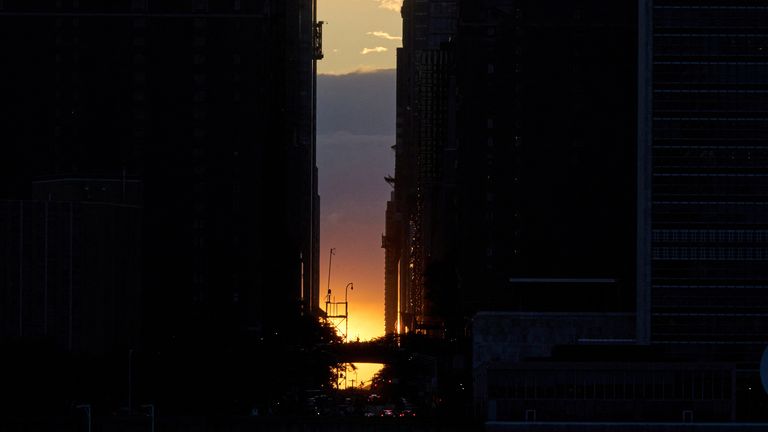Crowds gathered in New York on Tuesday evening as onlookers tried to catch a glimpse of ‘Manhattanhenge’.
The solar event that brings New Yorkers to the streets twice a year will continue tonight before disappearing from the skies once again.
So what is ‘Manhattanhenge’?
New York City is built on a grid. It’s a practical way of city planning, but also means that in May and July some of its long, straight streets become filled with light equally on both sides.
It gets its name from Stonehenge, the prehistoric monument on Salisbury Plain in Wiltshire. During the summer solstice, Stonehenge comes to life as the sun aligns with its standing rocks.
In a similar way, the streets of Manhattan fill with golden light when the setting sun perfectly aligns with the city’s grid.
The phenomenon draws thousands of people out to try and catch a glimpse – and to get a good photo.
Clouds thwarted them last night however, and the sun was mostly obscured.
There’ll be one more opportunity tonight, although the Met Office predicts the skies will be partially cloudy.
‘Manhattanhenge’ will then return on 12 and 13 July.
The American Museum of Natural History recommends 14th Street, 23rd Street, 34th Street, 42nd Street and 57th Street as good spots to watch the sunset.
“Find a spot as far east as possible that still has views of New Jersey across the Hudson River,” it says in a blog post on the phenomenon.
Why does it happen?
The point at which the sun sets on the horizon creeps north until the summer solstice, on 20 July this year, and then moves back south. This is because the Earth tilts on its axis as it rotates around the sun.
“Manhattanhenge may be a unique urban phenomenon in the world,” according to the American Museum of Natural History because the borough has a clear view of the horizon unlike many grid cities and its roads are perfectly straight.
It’s a special year for astronomy in the US.
Last month, people across the US, Canada and Mexico were treated to a total solar eclipse. People cried and cheered as the sun became obscured by the moon.
Then, earlier this month, night owls around the northern hemisphere got a surprise treat as the Northern Lights lit up the sky.
The sun is in its most active period in its 11-year cycle, meaning there may be more Northern Lights displays in the very near future.



























